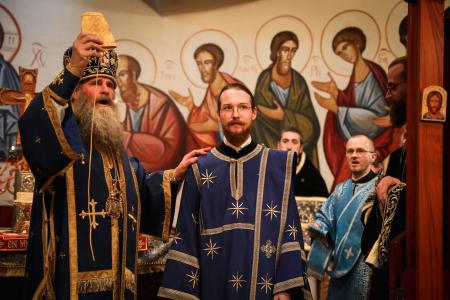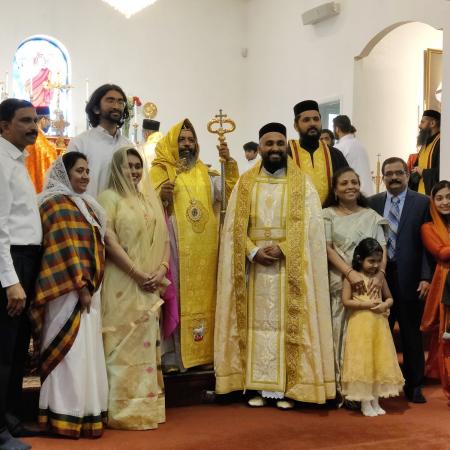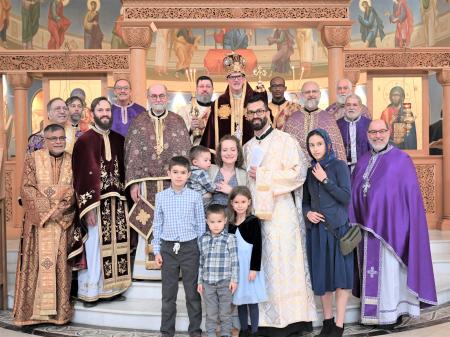Ordinations & Elevations: Spring 2022

Over St. Vladimir’s Seminary’s winter break and 2022 spring semester four new priests and seven new deacons were added to our student body and alumni fellowship. Another three were elevated in rank or received an ecclesiastical award. Added to previous ordinations and elevations last fall and summer, that makes one bishop, nine priests, eleven deacons, and eleven elevations in rank or ecclesiastical awards since the summer. Glory be to God!
We keep them all in prayer as they continue in their ministries. Axios!
HOLY PRIESTHOOD
PRIEST ANTHONY MACHNEE (3rd-Year Seminarian, M.Div. program)

Jurisdiction: Orthodox Church in America (OCA)
Holy Diaconate: Ordained 7FEB21 by the hand of His Beatitude, Metropolitan Tikhon at Three Hierarchs Chapel, St. Vladimir’s Seminary, Yonkers, NY
Holy Priesthood: Ordained 6JAN22 by the hand of His Eminence, Archbishop Benjamin at Holy Theophany Orthodox Church, Colorado Springs, CO
Educational and Professional Background: B.A. in psychology from the University of Saskatchewan, Saskatoon, Canada; Worked in trades doing residential constructions and renovations; homebuilding coordinator for Project Mexico and St. Innocent Orphanage’s summer volunteer program (2013-2014)
PRIEST JOSEPH OLAS (M.A., ’10)
Jurisdiction: Antiochian Orthodox Christian Archdiocese of North America (AOCANA)
Holy Diaconate: Ordained 3JUN17 by His Grace, Bishop Basil at St. George Orthodox Christian Church, Fishers, IN.
Holy Priesthood: Ordained 3APRIL22 by His Grace, Bishop Anthony at St. George Orthodox Christian Church, Fishers, IN
Current Ministry: Pastoral asst. at St. George Orthodox Christian Church, Fishers, IN
Educational and Professional Background: B.A. in liberal arts from Indiana University; served as outreach director at the Orthodox Christian Network (OCN)
PRIEST JOSEPH WESSELER (M.Div., ’17)

Jurisdiction: Orthodox Church in America (OCA)
Holy Diaconate: Ordained by His Grace, Bishop Irinej, (Serbian Orthodox Church), in Three Hierarchs Chapel, St. Vladimir’s Seminary, 13APR17
Holy Priesthood: Ordained 3APRIL22 by His Grace, Bishop Gerasim at St. John of the Ladder Orthodox Church, Greenville, SC
Current Ministry: Assigned to St. John of the Ladder Church, Greenville, SC
Educational and Professional Background: B.A. in philosophy with a minor in psychology from California State University, Fresno; Employed at Pro-Youth H.E.A.R.T. in Visalia, CA, an after school program providing homework help, supplemental math and reading work, and anti-gang and anti-drug education programs for youth
PRIEST ZACHARIAH (Jithin) ZACHARIAH (M.Div., ‘19)

Jurisdiction: Malankara Orthodox Syrian Church (MOSC)
Holy Diaconate: Ordained 25MARCH22 by His Grace, Zacharias Mar Aprem at St. Mary’s Malankara Orthodox Church of India, Carrollton, TX
Holy Priesthood: Ordained 9APRIL22 by His Grace, Zacharias Mar Aprem at St. Gregorios Malankara Orthodox Syrian Church, Garland, TX
Current Ministry: Priest of St. Gregorios Orthodox Church, Kansas City, MO
Educational and Professional Background: Bachelor’s degree in psychology from the University of Texas at Dallas; worked as chaplain at Faith Presbyterian Hospice, Dallas, TX and pharmacy clerk; intern/camp counselor at Rainbow Days, Inc. in the Dallas-Forth Worth area
HOLY DIACONATE
DEACON ANDREW SALVIA (2nd-Year Seminarian, M.Div. Program)

Jurisdiction: Antiochian Orthodox Christian Archdiocese of North America (AOCANA)
Holy Diaconate: Ordained 16JAN22 by the hand of His Eminence, Metropolitan Joseph at St. John the Baptist Antiochian Orthodox Church, Levittown, NY
Educational and Professional Background: B.A. in History from Roanoke College, Salem, VA; Worked in auto insurance and auto body industries as insurance adjuster and service advisor, assisting people dealing with insurance claims
DEACON PHILIP MCCLANAHAN (M.Div., ‘21)

Jurisdiction: Antiochian Orthodox Christian Archdiocese of North America (AOCANA)
Holy Diaconate: Ordained 27FEB22 by the hand of His Grace, Bishop Basil at St. George Orthodox Christian Cathedral, Wichita, KS
Current Ministry: Preparing for ministry as OCMC Missionary to Indonesia, teaching at St. Paul Theological School in the city of Medan and local Orthodox schools
Educational and Professional Background: Studied biblical studies at the University of Notre Dame; Served as missionary in the Middle East
DEACON BASIL PUTHUKKUNNATHU MATHAI (M.Div., ‘20)

Jurisdiction: Malankara Archdiocese of the Syrian Orthodox Church in North America
Holy Diaconate: Ordained 19MARCH22 by the hand of His Eminence, Archbishop Mor Titus Yeldho at St. Ephrem Cathedral, Malankara Archdiocesan Headquarters, Old Tappan, NJ
Current Ministry: Serves at St. Mary’s Jacobite Syrian Orthodox Church of White Plains, NY (Bronxville, NY); MGSOSA Northeast regional clergy advisor
Educational and Professional Background: B.A. in history & international affairs from the University of Georgia; M.A. in Middle Eastern Studies from Boston College; currently teaches history at a high school in Newark, NJ
DEACON ALEXANDER EARL (2nd-Year Seminarian, M.Div. Program)

Jurisdiction: Orthodox Church in America (OCA)
Holy Diaconate: Ordained 25MARCH22 by the hand of His Grace, Bishop Gerasim at Three Hierarchs Chapel, St. Vladimir’s Seminary, Yonkers, NY
Educational and Professional Background: M.A. in religion with a concentration in philosophical theology from Yale Divinity School (New Haven, CT); B.A. in religious studies and philosophy from Rollins College (Winter Park, FL); Continues to serve as director of the Center for Philosophy & Theology, as well as instructor, at Pacifica Christian High School in Santa Monica, CA, where he worked for several years prior to coming to seminary
DEACON JOHN VAZQUEZ (2nd-Year Seminarian, M.Div. Program)

Jurisdiction: Antiochian Orthodox Christian Archdiocese of North America (AOCANA)
Holy Diaconate: Ordained 2APRIL22 by His Grace, Bishop Anthony at St. George Orthodox Christian Church, Fishers, IN
Educational and Professional Background: Former professional baseball player and coach; B.A. in history from Kent State University
DEACON DAVID GALLOWAY (2nd-Year Seminarian, M.Div. Program)

Jurisdiction: Orthodox Church in America (OCA)
Holy Diaconate: Ordained 3APRIL22 by His Grace, Bishop Gerasim at St. John of the Ladder Orthodox Church, Greenville, SC
Educational and Professional Background: Studied English literature at Goldsmiths College, University of London and philosophy at Birkbeck College, University of London; Worked as a senior technical writer and IT project manager for two large ISPs and wrote for tech blogs including Lifehacker and Gizmodo
DEACON AARON RUTZ (M.Div., '20)

Jurisdiction: Orthodox Church in America (OCA)
Holy Diaconate: Ordained 1MAY22 by His Eminence, Archbishop Mark at Christ the Saviour Orthodox Church, Harrisburg, PA
Current Ministry: Attached to Christ the Saviour Orthodox Church, Harrisburg, PA
Educational and Professional Background: B.A. in theatre arts and philosophy at Sewanee: The University of the South; Thomas J. Watson Fellowship; worked in theater and event management; assistant to Rev. Joan Brown Campbell, former head of the National Council of Churches.
ELEVATIONS
ARCHPRIEST DANIEL BETHANCOURT (M.Div., ‘07)

Jurisdiction: Antiochian Orthodox Christian Archdiocese of North America (AOCANA)
Elevation to Archpriest: Elevated to the dignity of archpriest 5DEC21 at St. Nicholas Orthodox Church, Shreveport, LA
Current Ministry: Pastor of St. Nicholas Orthodox Church, Shreveport, LA
ARCHPRIEST CHARLES BAZ (M.Div., ‘00)

Jurisdiction: Antiochian Orthodox Christian Archdiocese of North America (AOCANA)
Elevation to Archpriest: Elevated to the dignity of archpriest 16JAN22 at St. John the Baptist Antiochian Orthodox Church, Levittown, NY
Current Ministry: Pastor of St. John the Baptist Antiochian Orthodox Church, Levittown, NY
PRIEST ALESSANDRO MARGHERITINO (M.Div., ‘14)

Jurisdiction: Orthodox Church in America (OCA)
Ecclesiastical Award: Awarded the gold cross 13APRIL22 at St. Sergius of Radonezh Chapel, OCA Chancery, Syosset, NY
Current Ministry: OCA Secretary




